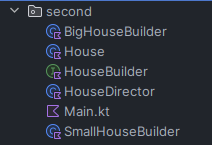Design patterns: Builder

Builder is one of creational design patterns. Main purpose of this pattern is to create objects of class in straight way, especially when object is complex and contains many fields. Using Builder we can avoid difficulties such as uncertain about the order of fields when creating an object of a given class or poor code readability.
Problem
I would like to indicate, that Builder is very universal design pattern. Actually, we can use it in many cases just to improve code readability, but I will point one typical case, when Builder may be necessary.
Imagine House. We can point many elements, which every house have. For example walls, floors, rooms, roof, windows etc. But we can also indicate additional elements, which some houses have, but not all. If you want to create House class, you have to be aware of creating many constructors inside the class specifically for each case. Finally, every house can consists of different elements, right?. It can be difficult to manage it all. Builder design pattern will help us solve this problem by enabling construction of object with the initialization of only fields, that we need.
Implementation with nested class (Kotlin)
Project structure

House.kt
class House private constructor(private val houseBuilder: HouseBuilder) {
private var walls: String = ""
private var floors: String = ""
private var rooms: String = ""
private var roof: String = ""
private var windows: String = ""
private var doors: String = ""
private var garage: String = ""
init {
walls = houseBuilder.walls
floors = houseBuilder.floors
rooms = houseBuilder.rooms
roof = houseBuilder.roof
windows = houseBuilder.windows
doors = houseBuilder.doors
garage = houseBuilder.garage
}
companion object {
class HouseBuilder {
var walls: String = ""
var floors: String = ""
var rooms: String = ""
var roof: String = ""
var windows: String = ""
var doors: String = ""
var garage: String = ""
fun buildWalls(walls: String): HouseBuilder {
this.walls = walls
return this
}
fun buildFloors(floors: String): HouseBuilder {
this.floors = floors
return this
}
fun buildRooms(rooms: String): HouseBuilder {
this.rooms = rooms
return this
}
fun buildRoof(roof: String): HouseBuilder {
this.roof = roof
return this
}
fun buildWindows(windows: String): HouseBuilder {
this.windows = windows
return this
}
fun buildDoors(doors: String): HouseBuilder {
this.doors = doors
return this
}
fun buildGarage(garage: String): HouseBuilder {
this.garage = garage
return this
}
fun build(): House {
return House(this);
}
}
}
override fun toString(): String {
return "House(walls='$walls', floors='$floors', rooms='$rooms', roof='$roof', windows='$windows', doors='$doors', garage='$garage')"
}
}
Main.kt
fun main() {
val house1 = House.Companion.HouseBuilder()
.buildWalls("walls")
.buildFloors("floors")
.buildRoof("roof")
.buildWindows("windows")
.build()
val house2 = House.Companion.HouseBuilder()
.buildWalls("walls")
.buildFloors("floors")
.buildRoof("roof")
.buildWindows("windows")
.buildRooms("rooms")
.buildGarage("garage")
.build()
println(house1)
println(house2)
}
Explanation
This is implementation of House class, which solve problem described in Problem section.
This class contains only private constructor, which receive object of HouseBuilder class, some fields related to house, HouseBuilder nested static class and overwritten toString() method.
HouseBuilder class consists of the same fields as House class and methods, which enable us to "build" house. buildSomeStuff() methods works in the same way: receives object and assigns it to appropriate field in HouseBuilder class. Each construction must end with invocation of build() method, which returns ready House object. Actually, we create House object now, from values assigned previously in HouseBuilder method. Code inside the init {} block is run.
In main method firstly we create two houses:
- First house consists of walls, floors, roof and windows.
- Second house consists of walls, floors, roof, windows, rooms and garage.
You can check output and verify, that objects are different and created with desired elements.
Your implementation can be different! Treat this as a typical demonstration example.
Extended problem
Imagine, that you have two car factories. Both produce cars from two specific car brands: Ford and BMW. Attributes, which distinguishes each car are engine capacity, fuel type and year of production. Consider, that one factory produce cars to the Great Britain and countries of the former British Empire market. Second export cars to countries such as Poland, Germany, Sweden or Spain. Difference between factories is that one should produce cars with steering wheel on the left position and second on the right position.
Classic implementation (Kotlin)
Project structure

HouseBuilder.kt
interface HouseBuilder {
fun buildWalls()
fun buildFloors()
fun buildRooms()
fun getHouse(): House
}
HouseDirector.kt
class HouseDirector(private val houseBuilder: HouseBuilder) {
fun buildHouse() {
houseBuilder.buildWalls()
houseBuilder.buildFloors()
houseBuilder.buildRooms()
}
fun getHouse(): House {
return houseBuilder.getHouse()
}
}
House.kt
class House {
var walls: String = ""
var floors: String = ""
var rooms: String = ""
override fun toString(): String {
return "House(walls='$walls', floors='$floors', rooms='$rooms')"
}
}
BigHouseBuilder.kt
class BigHouseBuilder : HouseBuilder {
private val house: House = House();
override fun buildWalls() {
house.walls = "big walls";
}
override fun buildFloors() {
house.floors = "big floors";
}
override fun buildRooms() {
house.rooms = "big rooms";
}
override fun getHouse(): House {
return house
}
}
SmallHouseBuilder.kt
class SmallHouseBuilder : HouseBuilder {
private val house: House = House();
override fun buildWalls() {
house.walls = "small walls";
}
override fun buildFloors() {
house.floors = "small floors";
}
override fun buildRooms() {
house.rooms = "small rooms";
}
override fun getHouse(): House {
return house
}
}
Main.kt
fun main() {
val smallHouseBuilder = SmallHouseBuilder()
val bigHouseBuilder = BigHouseBuilder()
val smallHouseDirector = HouseDirector(smallHouseBuilder)
smallHouseDirector.buildHouse()
val bigHouseDirector = HouseDirector(bigHouseBuilder)
bigHouseDirector.buildHouse()
val smallHouse = smallHouseDirector.getHouse()
val bigHouse = bigHouseDirector.getHouse()
println(smallHouse)
println(bigHouse)
}
Output

Explanation
Classic implementation seems to be much more complicated but nothing could be further from the truth! In fact, it is also really simple, if you understand it correctly.
So let's start with HouseBuilder. It is interface, which has a couple of buildSomeStuff() methods for constructing the respective parts of the house and getHouse() method, which will return House object after construction.
Next, HouseDirector class is responsible for directing the construction process. It has private constructor, which takes object of class, which implement interface described previously. This class has two methods:
- buildHouse(), which invoke each method from interface in a specific order on object received in constructor.
- getHouse(), which returns fully constructed House object. It is actually invocation of getHouse() method from interface.
House class consists of fields related to house (which we can "build" with methods included in interface) and overwritten toString() method.
BigHouseBuilder and SmallHouseBuilder have the same body. Both implements HouseBuilder interface, overwrittes methods from it and initializes private field of House type. Each builder sets the attributes of the House differently, depending on whether it's a small or big house.
In main method firstly we create objects of SmallHouseBuilder and BigHouseBuilder. Two HouseDirector objects are instantiated, each with a different, previously created builder. The buildHouse() method is called on each director, which uses the appropriate builder to construct the house. Finally, getHouse() method is invoked to retrieve built house objects, and they are printed to the console.
Your implementation can be different! Treat this as a typical demonstration example.
Pros and Cons
✅ Eliminates need of creating many constructors.
✅ Improves code readability and reduces the risk of mistake during creation of object.
✅ Object construction process is clearly defined and controlled. Instead of creating an object in one line of code, it is constructed step by step.
❌ In some implementations we need to create many classes. It can lead to overcomplication for simple objects.